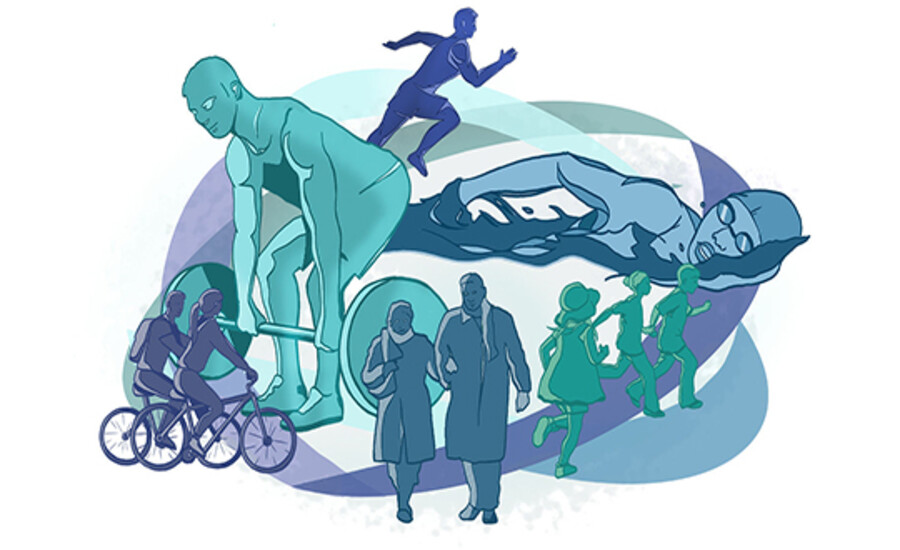
EMMA MOORE/TROMPET
Keep Moving Through The Decades
The law of inertia dictates that a body in motion stays in motion. This is also true of your human body: Continue to exercise as you age, and you will preserve your strength and vitality.
For thousands of years, human beings have had to move in our work, our transportation, our leisure, even to fetch water. But recent generations have designed our society to take our bodies out of motion: We sit at home, sit at school, sit at work, sit on vacation, sit for meals, sit as we commute. For most of us, daily life requires very little movement. A body at rest tends to stay at rest. And when bodies, young and old, that were designed to move do not move, they are sapped of their strength.
Less than a quarter of Americans now meet minimum exercise recommendations. In less than two generations, exercise has dropped by 32 percent. The National Institutes of Health report that chronic diseases are connected to a lack of physical activity. Keeping active will not only raise your quality of life, but statistics show it will lower your risk of major illness by 50 percent and reduce your risk of early death by roughly 30 percent.
The Centers for Disease Control and Prevention recommend at least 150 minutes of strength training and cardiovascular activity per week. Use the following advice to stay motivated and active through the decades.
Childhood
The cdc recommends 60 minutes per day of moderate to vigorous activity for children. Unfortunately, movement has largely been replaced with sitting in front of screens. The American Academy of Pediatrics says only 5.2 percent of U.S. children meet daily recommendations for exercise, so if you have children who are active compared to other children, they may need to become even more active for the best physical and mental health.
Very young children should be allowed plenty of free play with emphasis on fun, exploration and experimentation. As children get older, organized sports like soccer and swimming can help establish a healthy activity level.
Your 20s
When you are in your 20s, you should have high energy and a low body mass. You are able to work out strenuously and push yourself hard. Avoid injury, but know that strength is your friend. Focus on a combination of cardiovascular exercise and weight training, five times weekly. Challenge your cardiovascular system and all major muscle groups for a good foundation of health for later in life.
Your 30s
Family and career demands are intensifying, and you often have to work harder to fit healthy bodily movement into your schedule. A Muscle, Ligaments and Tendons Journal study found that muscle, bone mass and strength begin a steady decline of between 16 to 40 percent in the ensuing decades. Reduced amounts of your natural human growth hormone mean reduced metabolism and increased weight and body fat.
If you’re pressed for time, less can be more. Introduce circuit training into your routine, which combines resistance and cardio elements to keep fat-burning in high gear. Short, intense circuits with presses, pulls, squats or deadlifts build muscle, while cardiovascular fitness is maintained with high-intensity interval training.
Your 40s
In this decade, your hormones change further and metabolism slows more. Not long ago, doctors told people to slow down their exercising once they reached this age, thinking it would stress the heart.
Knowledge on this subject has changed, but it is true that recovery is harder and progress is slower than it was in your 20s and 30s. When exercising in your 40s: 1) stretch every session; 2) split total training sessions evenly between strength and cardio; and 3) listen to your body and reduce very hard sessions as needed.
Cross-training, combining anaerobic (functional strength and resistance movements) with aerobic (cardio) elements provides constant variation and higher intensity. Move hard now, or you will have to put in double the effort in the next decade to maintain the same level of health (Wholelifechallenge.com).
Your 50s
Major physical and physiological changes begin to appear when you are in your 50s. Your ligaments and tendons become less pliable, muscles become weaker, and it is easier to injure yourself. Due to this and other factors, it’s perhaps less appealing to exercise at all, which is why a shocking 41 percent of middle-aged people don’t even manage a brisk 10-minute walk once a month.
Do more than just that! Start with a warm up to prepare your muscles and avoid injury to your joints. Gently increase your activity levels, perhaps taking up light jogging, cycling, swimming or short strength-training workouts. Be mindful of fitness, injuries and individual ability to handle stress, but maintain a good level of intensity if you can.
Your 60s
In this decade, muscle mass more easily decreases, weight more easily increases, posture can degrade, and you may even suffer chronic health conditions. Perhaps you think it’s too late to start, but there is no expiration date on your body’s ability to benefit from physical activity. Any movement you begin to do right now will yield real, measurable and almost immediate benefits.
Harvard Health says that you still need five days of exercise per week. Get moving, even if it is only taking brisk walks at first. Work up to a 60-40 split between moderate aerobic activity and resistance exercise. That might seem daunting, but just focus on maintaining good form as you move, using appropriate weights and common sense. This will improve your bone health, general strength and long-term independence.
Your 70s and Beyond
If you are over 70, your best investment is still exercise. The older you are, the more dramatic the benefits of movement will be. This is especially true in preventing frailty and falls, maintaining cognitive function, and avoiding chronic diseases.
Focus on maintaining bone density, because of higher risk of death after a hip fracture. Regular exercise can lessen this danger by building strong bones and muscles.
Before starting, get advice from an exercise professional, especially if you have chronic conditions. Then start by increasing your level of movement slowly, perhaps with an invigorating walking program or a senior fitness class. If you have wobbly knees, try swimming instead of walking. If you struggle with mobility, check out eldergym.com for some excellent online exercises you can do at home.
It’s easy for an unmoving body to remain unmoving. But your body was created to move! Wherever you are in life, begin moving more, working toward the optimal combination for your age. Your journey toward better health begins with that first step.
